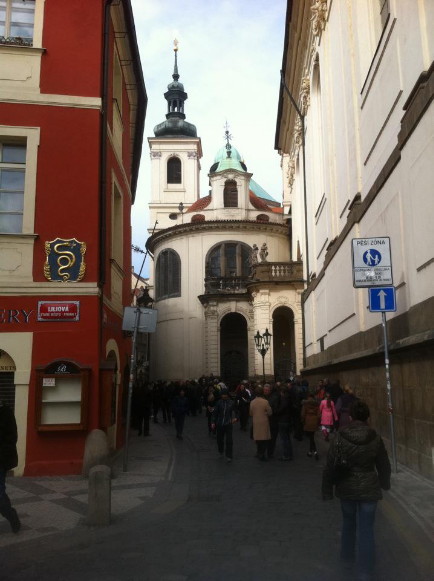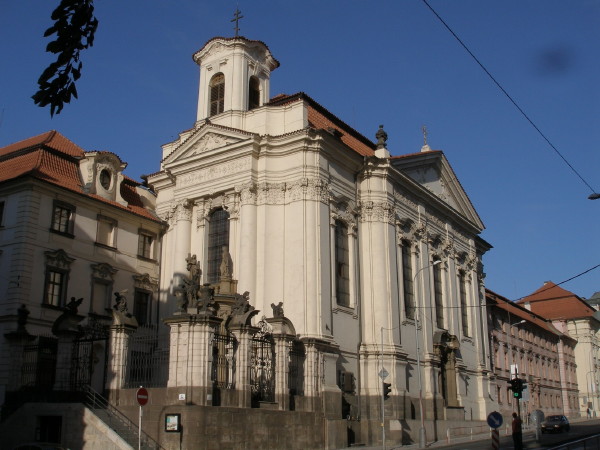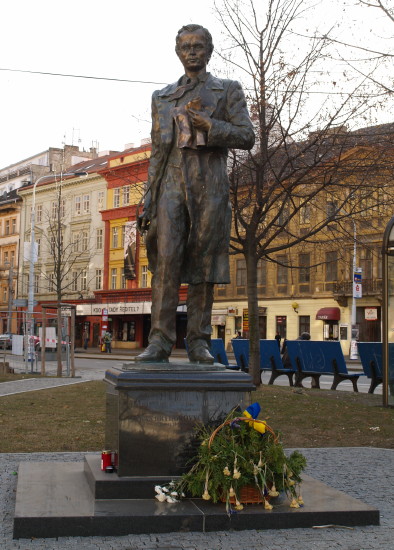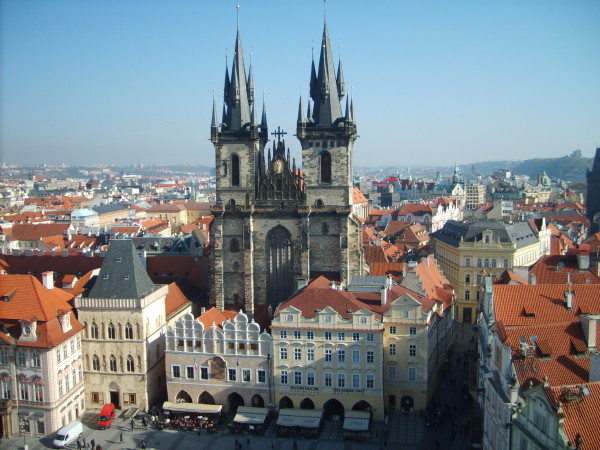Prague
Prague (Czech: Praha). The capital of and largest city in the Czech Republic (2011 pop 1,262,106), situated on the Vltava River. It is an important center for interaction between Slavs, and home to over 50,000 Ukrainians.
Trade relations between the city and Ukrainian territories were established in the 10th century along a route that originated in central Europe, passed through Prague, and then went on to Cracow, Kyiv, and, eventually, Asia. In the 11th century, Prague established direct relations with Kyivan Rus’. In the 14th century, Ukrainian students began traveling to Prague to study at Charles University (est 1348), and many of them quartered in a residence established in the late 14th century for Lithuanian, Belarusian, and Ukrainian students. Frantsisk Skoryna's Ruthenian Bible, which drew upon the earlier Czech Bible, was published in Prague in 1517–20 and had a profound effect on cultural life in Ukraine. S. Khlopytsky, an emissary of the Zaporozhian Sich, visited Prague in 1594–5.
During the Czech national revival in the early 19th century, there were scholars and writers in Prague who took an active interest in Ukraine; of note were František Čelakovský, J. Dobrovský, Karel Havliček-Borovský, J. Koubek, Pavel Šafařík, and Karel Vladislav Zap. Translations of Ukrainian literary works appeared in literary and academic periodicals, as did articles on Ukrainian culture and customs, particularly those written by Yakiv Holovatsky and Ivan Vahylevych. The presence of Osyp Bodiansky (1837–8) and Izmail Sreznevsky (1839–41) in Prague greatly spurred the growth of local interest in Ukraine, as did the participation of a delegation from Galicia at the Slavic Congress in Prague, 1848. In the 1850s and 1860s a number of Ukrainian cultural and political activists visited Prague, such as V. Bernatovych, I. Bilozersky, O. Bodiansky, Mykola Kostomarov, Panteleimon Kulish, Mykola Lysenko, Mykhailo Maksymovych, and Oleksander Potebnia. The gifts and parcels of books they had been sending from Ukraine for some time served as the basis for the rich Ukrainian collections in local libraries. In 1876 a two-volume edition of Taras Shevchenko's works that included previously censored poems was published in the city through the efforts of Oleksander Rusov. Ivan Franko made several significant presentations at the first Congress of Progressive Slavic Youth, held in May 1891. František Řehoř, who lived in the city from 1891, established a substantial Ukrainian collection at the Prague Museum with his generous donations of Ukrainian books and folk art items. Ivan Ya. Horbachevsky and Ivan Puliui, two eminent Ukrainian scholars, taught in postsecondary institutions in the city.
Ukrainian students studying in Prague established a hromada (1902); Olgerd Ippolit Bochkovsky, Ivan Bryk, and Lev Hankevych were active members. At the outbreak of the First World War many Ukrainian refugees came to Prague. A primary school was opened for their children in the nearby town of Nusle. The Ukrainian National Republic government maintained a mission, headed by Maksym Slavinsky, to the newly established Czechoslovak Republic in Prague, which later became a legation. It was superseded by an embassy of the Ukrainian Soviet Socialist Republic, headed by Mykhailo V. Levytsky.
Prague became the most important center of Ukrainian émigré cultural and political life in the 1920s, following a major influx of Ukrainian immigrants in 1920–1. It retained this position into the 1930s, even though a section of the emigration (particularly students) left the city. Many UNR officials and military figures settled in Prague; among them were Andrii Makarenko, Mykhailo Omelianovych-Pavlenko, Ivan Omelianovych-Pavlenko, Vsevolod Petriv, Serhii Shelukhyn, Fedir Shvets, and Andrii Yakovliv. Other political activists to arrive were members of the Ukrainian Social Democratic Workers' party (Olgerd Ippolit Bochkovsky, Panas Fedenko, Borys Matiushenko, and Isaak Mazepa) and an important group of the Ukrainian Party of Socialist Revolutionaries (Nykyfor Hryhoriiv and Mykyta Shapoval), which published the journal Trudova Ukraïna. Prague was the birthplace of the Ukrainian nationalist movement. The Group of Ukrainian National Youth, led by S. Nyzhankivsky and Yuliian Vassyian, was centered there, as was the League of Ukrainian Nationalists. The second conference of Ukrainian nationalists took place in Prague in 1928. Sovietophile elements gathered in the city in the 1920s around the Taras Shevchenko reading room, the Association of Citizens of the Ukrainian SSR, and the Zhovtneve Kolo literary association.
The Prague-based Ukrainian Civic Committee in Czechoslovakia oversaw the interests of Ukrainian émigrés in 1921–5. Many Ukrainian academic organizations were centered in Prague, the Ukrainian Academic Committee, the Ukrainian Scholarly Association, the Ukrainian Historical-Philological Society (est 1923), the Ukrainian Pedagogical Society in Prague, and the Ukrainian Society of Bibliophiles in Prague. Local museums and archives included the Museum of Ukraine's Struggle for Independence (1925–45, then 1945–8 as the Ukrainian Museum) and the Ukrainian Cabinet of History. Local Ukrainian secondary and post-secondary schools consisted of the Ukrainian Free University (1921–45), the Ukrainian Higher Pedagogical Institute (1923–33), the Ukrainian Studio of Plastic Arts (1923–45), and the Ukrainian Gymnasium in Czechoslovakia (1925–7). The Plast Ukrainian Youth Association and the Union of Ukrainian Plast Emigrés were also active in the city. The Ukrainian Academic Hromada was founded in 1919 as an organization of Ukrainian students; by March 1924 it had 1,255 members. There was also a wide range of other student organizations and professional organizations. The Central Union of Ukrainian Students was located there in 1922–35, and it held several congresses and two academic conferences in the city. Prague was also the residence of many Ukrainian writers (Oleksander Babii, Mykola Chyrsky, Yurii Darahan, Myroslav Irchan, Ivan Irliavsky, Ivan Krushelnytsky, Oksana Liaturynska, Yevhen Malaniuk, I. Narizhna, Oleksander Oles, Oleh Olzhych, Antin Pavliuk (Yavir), Ulas Samchuk, Oleksa Stefanovych, and Olena Teliha), artists (Mykhailo Brynsky, Mykola Butovych, Vasyl Kasiian, Vasyl Khmeliuk, Ivan Kulets, Robert Lisovsky, Halyna Mazepa, and Volodymyr Sichynsky), and scholars (Dmytro Antonovych, Leonid Biletsky, Dmytro Chyzhevsky, Stanyslav Dnistriansky, Dmytro Doroshenko, Oleksander Kolessa, I. Panas, Ivan Pankevych, Stepan Rudnytsky, Sofiia Rusova, Stepan Siropolko, Stepan Smal-Stotsky, Andrii Yakovliv, and Ivan Zilynsky).
Prague was also an important Ukrainian publishing center; the Siiach (1924–33), Proboiem (1939–43), Kolos, Yu. Tyshchenko, and Ye. Vorony publishing houses were active there. Periodicals published in Prague included Nova Ukraïna (Prague) (1922–8), Students’kyi visnyk (1923–31), Rozbudova natsiï (1928–34), Proboiem (1933–43), Nastup (biweekly, 1934–44), and Ukraïns’ka diisnist’ (biweekly, 1940–5).
Ukrainian émigré scholars maintained healthy relations with their Czech counterparts, and their works were printed in Czech academic journals. From 1926 Ukrainian language and literature were taught at Charles University. The visits of Ukrainian writers and artists in the 1920s also stimulated interest in Ukrainian creative work: Oles Dosvitnii, Valeriian Polishchuk, and Pavlo Tychyna in 1925; Mykhailo Boichuk, Les Kurbas, and Vasyl Sedliar in 1927; Olha Kobylianska, Oleksander Kopylenko, Arkadii Liubchenko, and Valeriian Pidmohylny in 1928; and Oleksander Dovzhenko in 1930.
During the Second World War a large number of Ukrainians arrived from Transcarpathia as well as Western Ukraine to enroll in Prague's schools. In mid-1939 the government of Carpatho-Ukraine, led by Avhustyn Voloshyn, moved to Prague. In 1944 a large contingent of scholars from central Ukraine reached the city.
With the arrival of the Soviet Army in 1945, the number of Ukrainians in the city declined sharply, since most had fled to Germany. Others came, however, including soldiers from Czech units in the Soviet Army and students from Prešov. Nevertheless, Ukrainian organizations and institutions were disbanded and closed. The last to go were the Ukrainian Museum (1948) and Ivan Kulets's painters' school (1952). In 1946–8 the Russophile journals Kostër and Karpats’kaia zvezda came out. Currently there is only a small group of independent artists and a choir led by O. Prykhodko and Platonida Shchurovska-Rosinevych active in the city. In 1968 the Greek Catholic parish was reopened. The metropoly of the autocephalous Orthodox Church of the Czech Lands and Slovakia is centered in Prague.
Prague has also become an important translation center for Ukrainian literature. Since the war nearly 300 titles have been translated and published, and the Czech artists' union had a section devoted to translation of Ukrainian literature, headed by Rudolf Hůlka and M. Marčanová. Charles University had a department of Ukrainian language and literature, headed by Ivan Zilynsky and Ivan Pankevych, where Zina Genyk-Berezovska, J. Moravec, and V. Židlický worked. A Ukrainian language-instruction textbook for Czechs was published in Prague, as were a number of texts on Ukrainian literature (including anthologies) and history. The Slavic Library in Prague, which contains nearly 50,000 Ukrainian titles, is an important storehouse of Ukrainian culture. Its holdings include valuable religious manuscripts, such as the Apostolos by Ivan Fedorovych (Fedorov), Petro Mohyla's Euchologion, and the Ostroh Bible. The city's archives also contain many valuable Ukrainian materials. The celebrations of Taras Shevchenko's anniversaries in 1951, 1961, and 1989, with their attendant exhibitions, were of cultural importance, as was an Ivan Franko festival held in 1956, at which a commemorative plaque was unveiled. Shevchenko’s monument was unveiled in Prague in 2009. Today several Ukrainian associations are active in Prague, including the Association of Ukrainians and Friends of Ukraine, the Association of Ukrainian Women in the Czech Republic, and the Dzherelo theater group. The most important Ukrainian periodicals published in Prague are the illustrated magazine Ukraïns'kyi zhurnal and a bi-monthly newspaper Porohy.
BIBLIOGRAPHY
Halahan, M. Desiat’ rokiv Ukraïns’koï hromady v ChSR: Ohliad zhyttia i chynnosty (1927–37) (Prague 1938)
Antonovych, M. 20 rokiv Ukraïns’koï akademichnoï hromady v Prazi (Prague 1941)
Narizhnyi, S. Ukraïns’ka emigratsiia (Prague 1942)
Orest Zilynsky
[This article was updated in 2013.]



